(This is part two of teacher Julie DiMaio’s blog. In part one Julie describes her participation in the San Mateo Environmental Learning Collaborative summer 2015 teacher institute. In part two she shares the outcome of her work and the impact the unit she developed had on her students.)
Once Jerry told us that the Environmental Education Initiative (EEI) units had been written for the old science standards and encouraged us to use materials from other grades if they met our purpose, we started searching through the EEI materials using a conversion guide to narrow the options. We found a third grade unit that had a great story about the Sweetwater Marsh in Chula Vista that we thought would build good background knowledge and vocabulary. Then we started connecting dots.
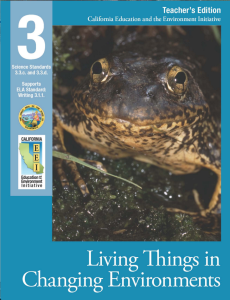
We had found our focus:
|
We continued to work to include all the elements of the NGSS alphabet. We had a template and guidance from Jerry and Grace Lieberman. A deadline and regular check-ins helped keep this a priority so that it didn’t get lost in the hustle and bustle of everyday teaching reality.
The Unit in a Nutshell
Lesson 1: Define the problem. Every year for the last four years, the upper-grade students at Lomita Park have participated in the Coastal Cleanup Day. Debi and I wanted to use this as a launch for a unit on the environment that would lead our students to real, authentic advocacy. We worked with Gerald Schwartrz at Recycle Works to develop a lesson using their resources. The City of Millbrae supplied the cleanup materials (pickers, buckets, and gloves). The entire upper grade (over 100 students) cleaned up garbage and tallied the items. Students were surprised to find out the largest source of trash on campus was snack wrappers. (They had predicted it would be cigarette butts!) They immediately wanted to start making posters and spreading the word about the trash problem. Capitalizing on their enthusiasm, we brainstormed ideas and the kids made signs on their own time. There was no holding them back. This is when I started to feel the growing power of the unit. If they were this energized and enthusiastic already, I couldn’t wait to see where this unit would take us.
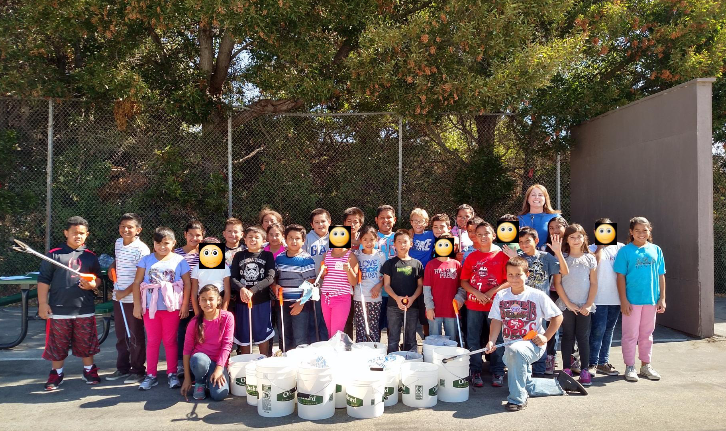
Lesson 2: Understanding options. Debi and I felt it was important to build a common understanding of environmental issues related to human impact on ecosystems. It was crucial to develop a common vocabulary so that everyone would have equal access to the lesson. I taught several lessons from the EEI Curriculum, 3.3.c. and 3.3.d. Living Things in Changing Environments: Living things (including humans) can cause changes in the environments in which they live. The students read a story about the Sweetwater Marsh near Chula Vista, California. There were several activities about the human systems that caused changes in the animal and plant populations in the area. Students learned about the structural adaptations that enabled these populations to thrive in the marsh, how they were damaged by the changes brought about by human activity, and how they are now returning to the restored marsh.
Lesson 3: Expanding the scope. We didn’t want the students to be limited in their solutions to only the experiences they had read about in the EEI materials. We also wanted to expand their vocabulary and understanding of what is being done for animal and plant populations in other habitats. Given the wide range of language and reading abilities in the class, we opted to use articles from www.newsela.com so that all students would have access to the same content for discussions. In addition, I brought in articles from the local newspaper describing the importance of restoring the salt flats in the San Francisco Bay. The articles were challenging but brought the question of restoration close to home and enabled students to learn real-life reading strategies.
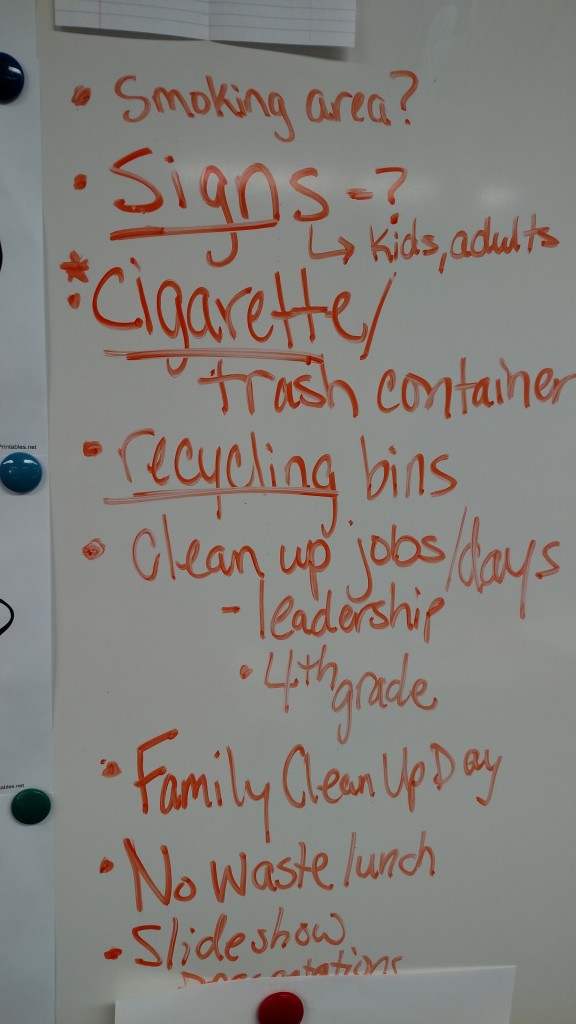
Lesson 4: Bringing it current. For the last couple of years, the Tuolumne River Trust has sent someone to talk with our fourth graders about the drought, water conservation, where our water comes from, etc. This year, I asked the presenter to also include information about how the Hetch Hetchty Dam project effected the plant and animal populations of the area. The presenter involved the kids in a hands-on demonstration of how water use is distributed among agribusiness, industry, households, and nature. Once the students realized that animals and plants can’t really cut water consumption, they realized that humans need to cut back. With guidance from the presenter, they came up with many ways for all the stakeholders to cut back.
Lesson 5: Animal comparisons. In order to get the most out of our next presenter, it was important for the students to know how to compare the structure of animals and relate it to survival. In order to do this, I provided short, cloze-reading articles comparing similar but different animals. Since it was close to Halloween, we had some fun with this. We compared Komodo dragons to other lizards, vampire bats to other bats, etc. Students gained valuable experience using Venn diagrams to compare similar animals.
Lesson 6: The main event. Natalie Reeder is the SFO biologist. She met with me to design her presentation. I asked her to talk about her educational preparation and previous experience. I think it is important for students to know what people do to prepare for their jobs. It is one thing to say you want to be a vet, for example, and another to know how to get there. After about an hour we came up with some “talking points” that would address the life science standard and all of the other NGSS alphabet pieces. We agreed she would focus on the two frog species in the area as a way to really highlight the structure and function for survival aspect. When she asked if she could bring along some animals, my answer was an enthusiastic, “YES!” Unfortunately, she couldn’t bring any endangered animals but she brought close cousins.
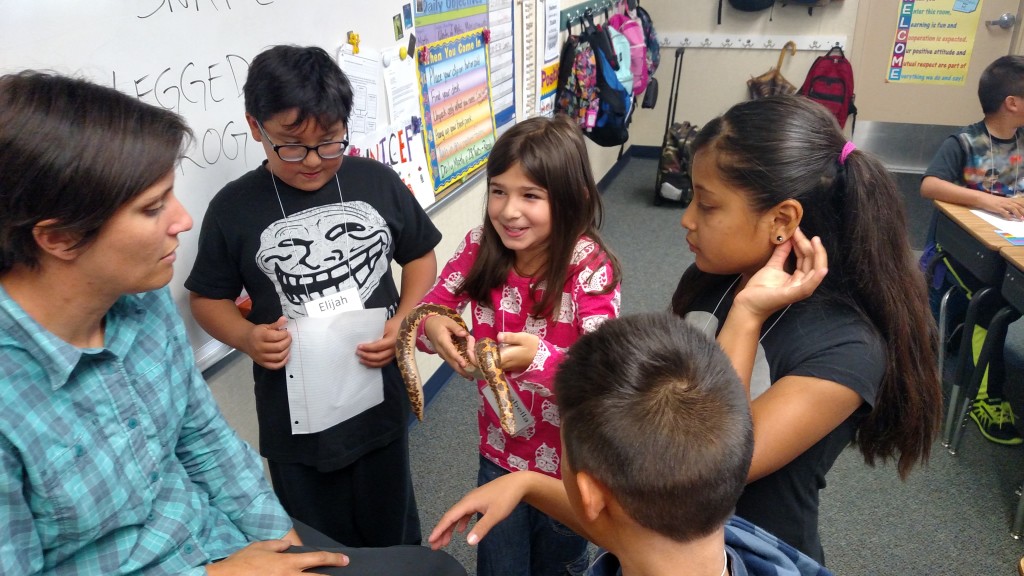
Ms. Reeder arrived after recess one day. She was very engaging speaker and held my students’ attention from the first word. Sensing they were more interested in the animals than in her education, Ms. Reeder breezed quickly through the introduction, letting the kids know her background and current duties. Then she showed her first slide: a side-by-side comparison of the Chorus Frog (now Sierra Tree Frog), a loud, frequent visitor to our campus and the endangered California Red-legged Frog, preferred prey of the endangered San Francisco Garter Snake. My students are used to working in pairs so she encouraged them to discuss what they observed about the two animals. Pairs then shared out to the whole class (one is big, one is more green, one has a stripe by its eye). As predicted, they didn’t mention the differences in feet structure so she went to the next slide: a side-by-side close up of the feet showing the webbed toes of the Red-legged and the toe-pads of the Sierra Tree Frog. She asked student pairs to hypothesize about the need for these differences. Students guessed the relative functions of swimming and climbing. This led to the third slide: the frogs in their habitat (Red-legged camouflaged at the bottom of a pond and the Sierra in a tree). She then discussed what constituted a healthy environment and what we could do to help.
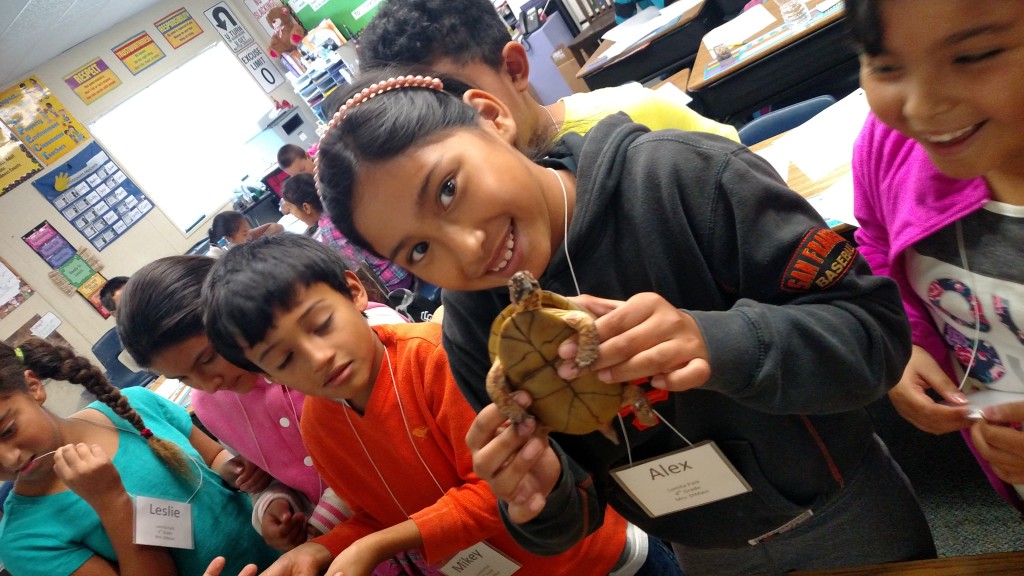
The students were directed to complete a Venn diagram and then write a comparison of the two frogs while they waited their turns with the animal ambassadors. Ms. Reeder showed the Sierra Tree Frogs that she had collected the night before and planned to return later that afternoon. She could not bring the other animals that were discussed as they are protected. She did bring her friend’s snake so that the students could see and experience the structure of a snake close up. And just for fun, she brought a turtle. Students thoroughly enjoyed the animal ambassadors and Ms. Reeder’s comfortable sharing of information. Her interest and passion for science was definitely contagious. By the end of her presentation, the students were clamoring to do something to help our vulnerable neighbors.
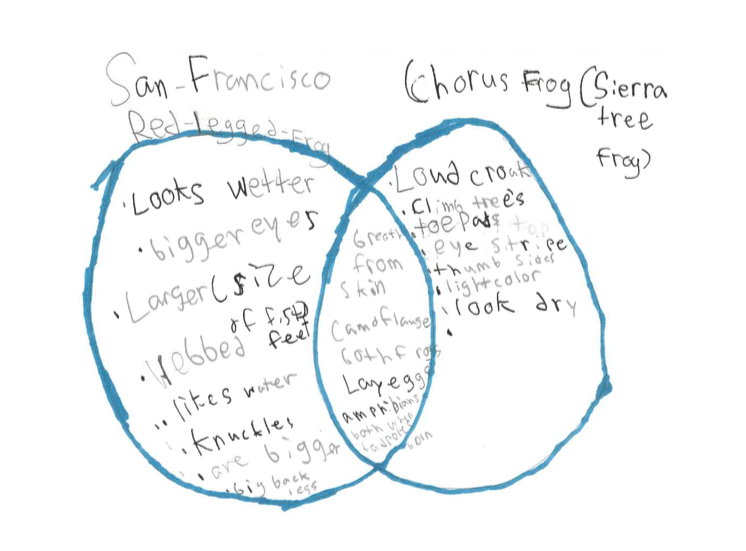
Lesson 7: Advocacy in action. I led students through a brainstorm of what could be done to help these animals. There was quite a list. A student suggested that we tear down the school since the frogs were here first. Another wanted to make signs. A third suggested more cleanup days. Finally, someone said they should tell everyone in the school to trash their trash. They decided the best way to do this is by creating Keynotes Slides on the iPads.
Next, we explored how many slides we needed and what the content should be. I asked them to work in pairs to maximize collaboration. Critical thinking skills helped students choose the content, information, and photos to be included. One day a student said he could not find the right photo of trash online and asked if he could take a photo of the real trash with the iPad. Yes! Several teams followed suit. This unit was authentic and relevant. They had a real purpose for the communication. Pairs presented work in progress to our class for critique. I could not believe what unfolded next. Examples of student comments:
“I really appreciate the effort you put into selecting your photos. However, I feel your special effects obscure your message.”
“I like that you tell them to put their trash away but you need to check your homophones. I think you mean ‘too’ not ‘to.’”
It went on like this for a few days as each group presented. My grammar and punctuation lessons were embedded. We also discussed not reading slides but speaking from our hearts. This was really liberating for my struggling readers.
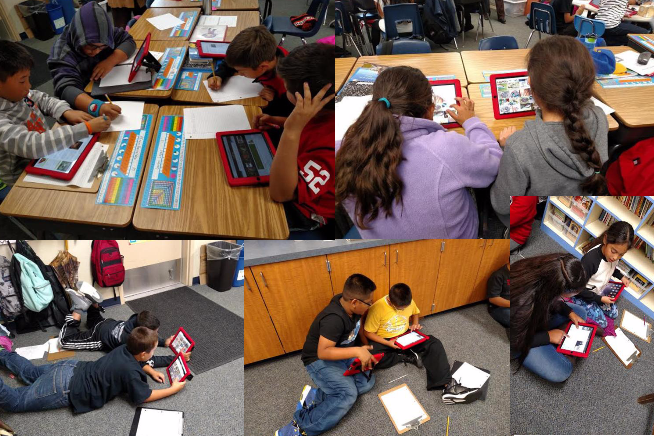
After a few days of adjustments, my students presented to other classes at the school. Each class got to see 3-5 pairs present. After the Winter Concert, parents came to the room to see their students’ presentations. As members of the community, we wanted them to do their part to limit litter. Debi invited the Superintendent, Assistant Superintendent, Reading Resource teacher, and Sheriff’s School Resource Officer to a special showing. Every single pair said they would be proud to present to the dignitaries. Due to time constraints we randomly selected 6 and chose 2 other pairs to be docents to lead a tour of the fence line. The Superintendent was so impressed that I was asked to present our work to the school board as part of the annual LCAP presentation.
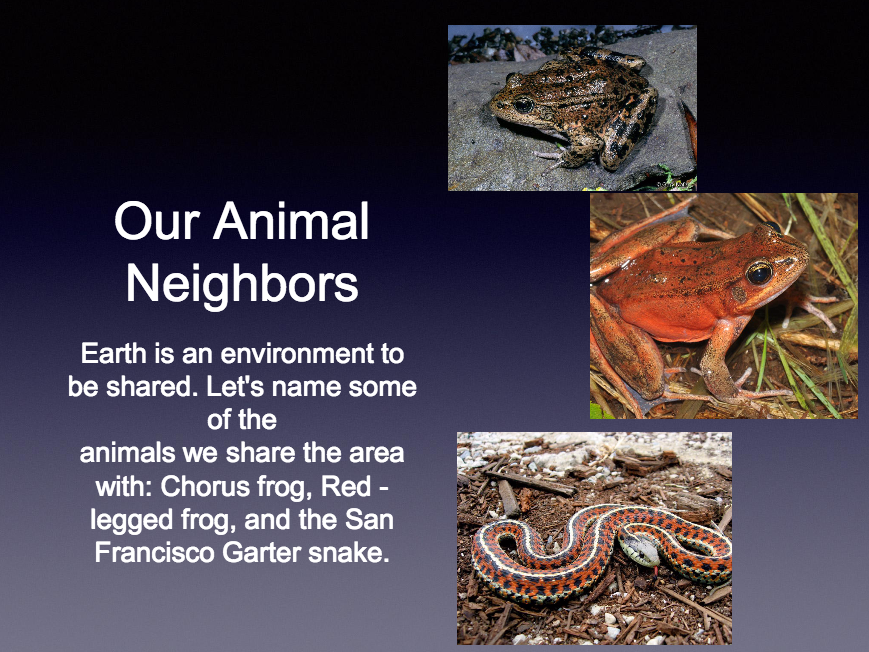
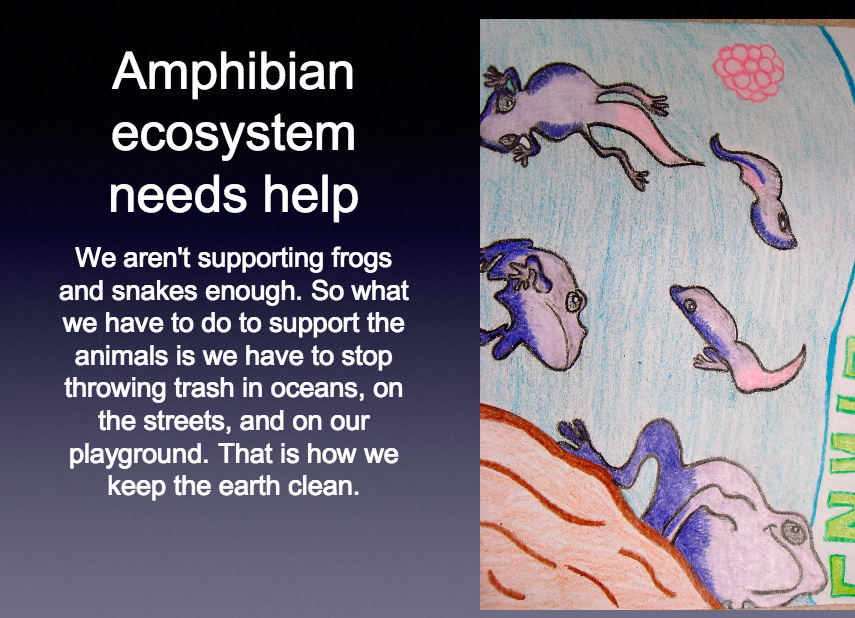
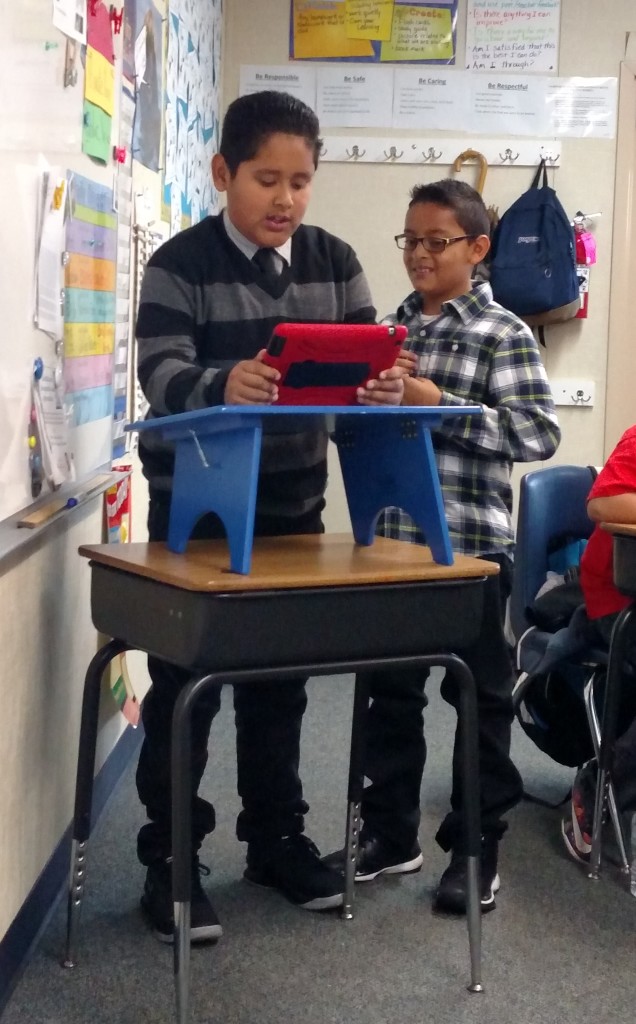
As I reflect on this experience, this unit is one of the achievements I am most proud of in my teaching career. This unit includes the 4 C’s of the CCSS: Collaboration, Creativity, Communication, and Critical Thinking. Students certainly develop listening and speaking skills. It is student-centered and driven, and differentiated. Students were proud of their work. Throughout the unit, they were self-motivated and engaged. They had a sense of purpose: the unit was both relevant and authentic. Not a single one asked what their grade was. It didn’t matter: They knew they made a difference and they felt honored.


3 Responses
You are an awesome teacher and I enjoyed reading this. The photos are terrific! Keep up the fantastic work!
A great plan to develop awareness in young children to the environment around them and the need to protect it.
Julie, thank you for sharing your blog and thank Ten Strands for providing the platform to do so. I love your unit! Reading about the planning and implementation took me back to my days of teaching grades 3, 4, and 5. Seeing the pictures of your students made me smile and feel wistful for the days I spent with young learners. Teachers have an incredibly difficult job, but it is filled with amazing rewards.